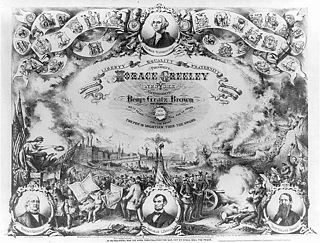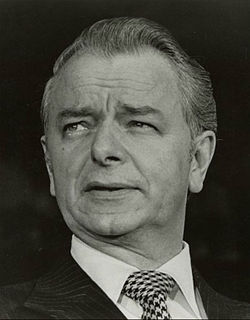
The United States presidential election of 1856 was the 18th quadrennial presidential election, held on Tuesday, November 4, 1856. In a three-way election, Democrat James Buchanan defeated Republican nominee John C. Frémont and American Party nominee Millard Fillmore.

The 1860 United States presidential election was the nineteenth quadrennial presidential election to select the President and Vice President of the United States. The election was held on Tuesday, November 6, 1860. In a four-way contest, the Republican Party ticket of Abraham Lincoln and Hannibal Hamlin emerged triumphant. The election of Lincoln served as the primary catalyst of the American Civil War.

Thomas Miller McClintock II is an American politician who is the U.S. Representative for California's 4th congressional district, serving since 2009. A member of the Republican Party, he previously served as an assemblyman and state senator. McClintock unsuccessfully ran for Governor of California in the California recall election and for Lieutenant Governor of California in the 2006 election.

Edmund Gerald "Pat" Brown Sr. was an American politician and lawyer who served as the 32nd Governor of California from 1959 to 1967. Born in San Francisco, Brown had an early interest in speaking and politics; he earned a LL.B. degree in 1927, and subsequently began legal practice. His first elected office was as district attorney for San Francisco, he was elected attorney general of California in 1950 before becoming the state's governor in 1959. As governor, Brown embarked on massive projects, building important infrastructure and redefining the state's higher education system. He was never a serious contender in the national conventions, although frequently on primary ballots as California's favorite son. He lost his bid for a third term as governor in 1966 to future President Ronald Reagan, but his legacy has since earned him regard as the builder of modern California. His son Edmund G. "Jerry" Brown Jr. was the 34th and 39th Governor of California; his daughter, Kathleen Brown, was the 29th California State Treasurer.

The Constitutional Union Party was a political party in the United States created in 1860 which ran against the Republicans and Democrats as a fourth party in 1860. It was made up of conservative former Whigs who wanted to avoid secession over the slavery issue. These former Whigs teamed up with former Know Nothings and a few Southern Democrats who were against secession to form the Constitutional Union Party. The party's name comes from its simple platform, which consists of the resolution "to recognize no political principle other than the Constitution of the country, the Union of the states, and the Enforcement of the Laws". The party hoped that by not taking a firm stand either for or against slavery or its expansion, the issue could be pushed aside.

The Liberal Republican Party of the United States was an American political party that was organized in May 1872 to oppose the reelection of President Ulysses S. Grant and his Radical Republican supporters in the presidential election of 1872. The party emerged in Missouri under the leadership of Senator Carl Schurz and soon attracted other opponents of Grant. The party opposed Grant's Reconstruction policies and sought civil service reform. It lost in a landslide and disappeared after the 1872 election.

John Conness was a first-generation Irish-American businessman who served as a U.S. Senator (1863–1869) from California during the American Civil War and the early years of Reconstruction. He introduced a bill to establish Yosemite National Park and voted to abolish slavery. His advocacy of Chinese immigration and civil rights cost him his constituency.

The 1988 United States Senate elections was an election for the United States Senate in which, in spite of the Republican victory by George H. W. Bush in the presidential election, the Democrats gained a net of one seat in the Senate. Seven seats changed parties, with four incumbents being defeated. The Democratic majority in the Senate increased by one from 54/46 to 55/45.

The 1986 United States Senate elections was an election for the United States Senate in the middle of Ronald Reagan's second presidential term. The Republicans had to defend an unusually large number of freshman Senate incumbents who had been elected on President Ronald Reagan's coattails in 1980. Democrats won a net of eight seats, defeating seven freshman incumbents and regaining control of the Senate for the first time since January 1981. The party not controlling the presidency gained seats, as usually occurs in mid-term elections.

The 1978 United States Senate elections in the middle of Democratic President Jimmy Carter's term. Thirteen seats changed hands between parties. The Democrats at first lost a net of two seats to the Republicans, and then one more in a special election. Democrats nevertheless retained a 58-41 majority.

The 1970 United States Senate elections was an election for the United States Senate, taking place in the middle of Richard Nixon's first term as President. The Democrats lost a net of three seats, while the Republicans and the Conservative Party of New York picked up one net seat each, and former Democrat Harry F. Byrd Jr. was re-elected as an independent.

The 1966 United States Senate elections was an election on November 8, 1966 for the United States Senate which occurred midway through the second term of President Lyndon B. Johnson. With divisions in the Democratic base over the Vietnam War, and with the traditional mid-term advantage of the party not holding the presidency, the Republicans took three Democratic seats. Despite Republican gains, the balance remained overwhelmingly in favor of the Democrats, who retained a 64–36 majority. This was also the first election that occurred after the Voting Rights Act of 1965 became law.

The 1964 United States Senate elections coincided with the election of President Lyndon B. Johnson by an overwhelming majority, to a full term. His Democratic Party picked up a net two seats from the Republicans. As of 2019, this is the last time either party has had a two-thirds majority in the Senate, which would have hypothetically allowed the Senate Democrats to override a veto, convict and expel certain officials, or invoke cloture without any votes from Republicans. The Senate election coincided with Democratic gains in the House in the same year.

The 1950 United States Senate elections occurred in the middle of Harry S. Truman's second term as President. As with most 20th-century second-term mid-terms, the party out of the Presidency made significant gains. The Republican opposition made a net gain of five seats, taking advantage of the Democratic administration's declining popularity during the Cold War and the aftermath of the Recession of 1949. The Democrats held a narrow 49 to 47 seat majority after the election. This became the first time since 1932 that the Senate Majority Leader lost his seat and the only instance where the majority leader lost his seat while his party retained the majority.

Elections to the United States House of Representatives for the 37th Congress were held at various dates in different states from August 1860 to October 1861.

Elections to the United States House of Representatives for the 36th Congress were held during President James Buchanan's term at various dates in different states from August 1858 to November 1859.

In the 1856 United States presidential election, California voted for the Democratic nominee, former Secretary of State James Buchanan, over the American Party nominee, former Whig President Millard Fillmore, and the Republican nominee, former U.S. Senator and Military Governor of California John C. Frémont.

A Massachusetts general election was held on November 6, 1990 in the Commonwealth of Massachusetts.

The 1859 California gubernatorial election was held on September 7, 1859 to elect the governor of California.





















